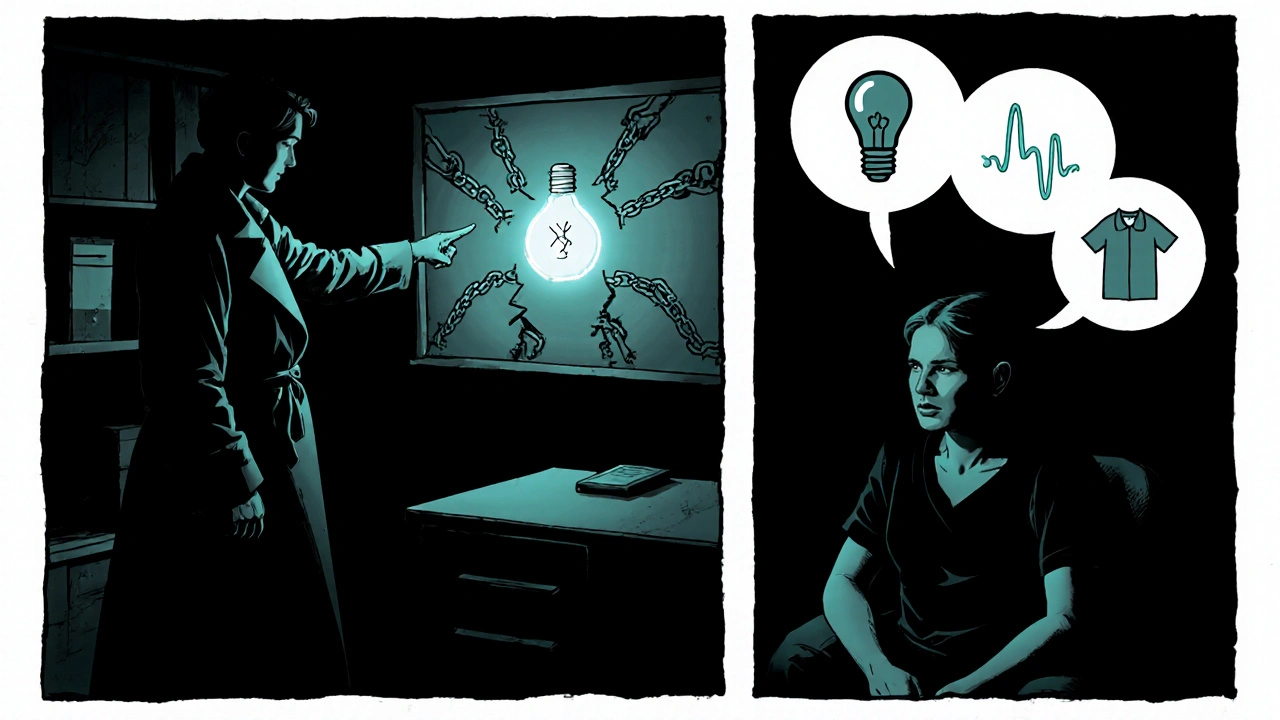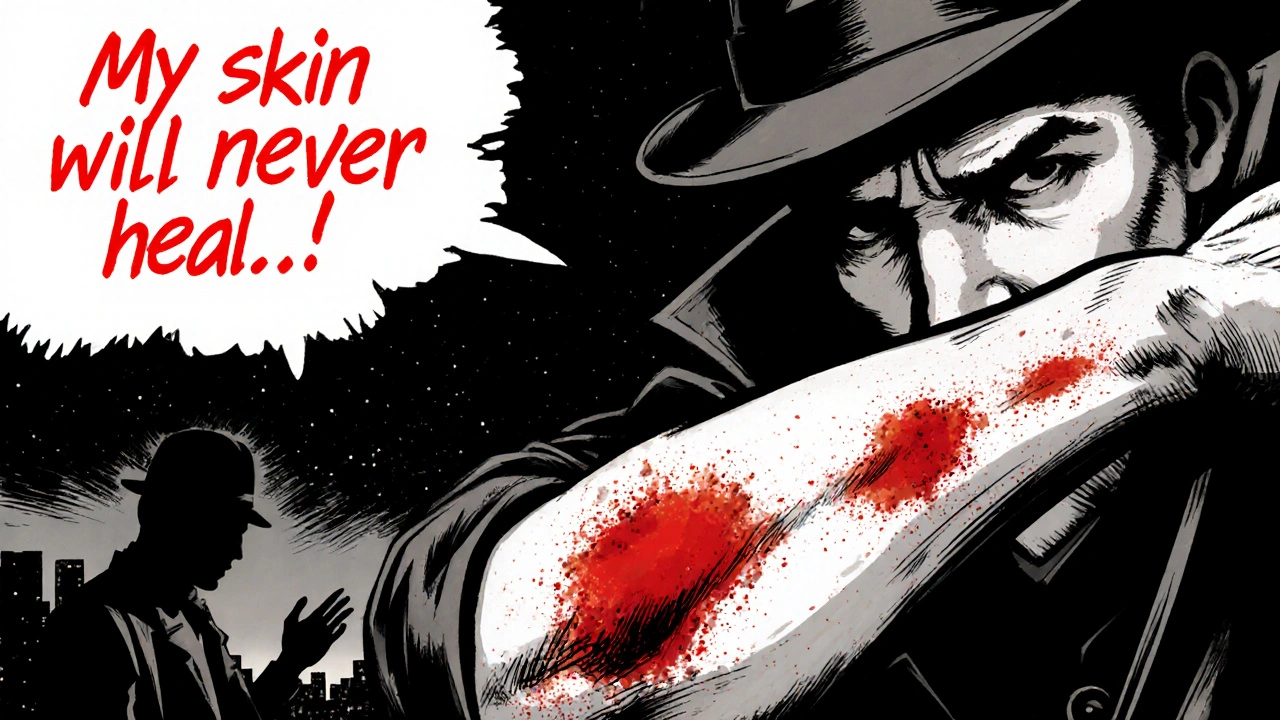CBT Pain Reduction Calculator
How CBT Can Help Reduce Your Skin Pain
Cognitive Behavioral Therapy can reduce skin pain by 20-35% according to clinical studies. This calculator estimates potential pain reduction based on your current pain level.
CBT helps change unhelpful thoughts and behaviors that amplify pain, reducing stress and improving coping strategies for conditions like eczema, psoriasis, and dermatitis.
When chronic skin conditions turn painful, the struggle goes beyond physical symptoms. Cognitive Behavioral Therapy is a structured, goal‑oriented talk therapy that helps rewire the thoughts and behaviors fueling that pain. CBT teaches patients to challenge unhelpful beliefs, reduce stress, and adopt healthier coping strategies. Pair that with a clear view of Skin Pain pain originating from dermatological conditions such as eczema, psoriasis, or chronic dermatitis, and you have a powerful, non‑pharmacologic option that many overlook.
What Exactly Is Skin Pain?
Skin pain isn’t just a fleeting itch. It’s a complex sensation that can be sharp, burning, or throbbing, often linked to inflammation, nerve irritation, or psychological stress. Conditions like psoriasis, eczema, and chronic dermatitis regularly trigger pain pathways, while factors such as anxiety or depression can amplify the perception of pain.
- Inflammatory component: Cytokines released during flare‑ups sensitize nerve endings.
- Neuropathic component: Long‑standing inflammation can damage cutaneous nerves, leading to persistent pain.
- Psychological component: Stress and catastrophizing thoughts increase pain intensity.
Understanding these layers is the first step toward effective management.
Understanding Cognitive‑Behavioral Therapy
Cognitive‑Behavioral Therapy a short‑term, evidence‑based psychotherapy that targets the relationship between thoughts, emotions, and behaviors works by identifying unhelpful mental patterns and replacing them with realistic, constructive alternatives. In the context of skin pain, CBT tackles three main areas:
- Thoughts: Challenging catastrophizing beliefs like “My skin will never heal.”
- Behaviors: Reducing scratching or avoidance that worsen lesions.
- Physical sensations: Teaching relaxation techniques to calm the nervous system.
The therapy typically runs 8‑12 weekly sessions, each lasting 45‑60 minutes, and incorporates homework to reinforce new skills.
How CBT Alleviates Skin Pain
CBT influences skin pain through several mechanisms:
- Stress reduction: Lower cortisol levels decrease inflammation.
- Pain re‑interpretation: Patients learn to view pain as a signal, not a threat.
- Behavior modification: De‑scaling of compulsive scratching limits skin barrier damage.
- Enhanced self‑efficacy: Confidence in managing symptoms reduces overall distress.
These changes create a positive feedback loop: less pain leads to lower stress, which in turn lessens pain.
Core CBT Techniques for Managing Skin Pain
Therapists often blend several tools to suit each patient’s needs:
- Cognitive Restructuring: Spotting and disputing exaggerated thoughts about skin condition severity.
- Exposure Therapy: Gradual, controlled exposure to situations patients avoid (e.g., wearing short sleeves) to diminish fear.
- Mindfulness‑Based Stress Reduction (MBSR): Grounding exercises that keep attention on the present moment, reducing rumination.
- Behavioral Activation: Scheduling enjoyable activities that shift focus away from pain.
- Relaxation Training: Deep breathing, progressive muscle relaxation, or guided imagery to calm the autonomic nervous system.
Homework often includes a pain diary, tracking triggers, thoughts, and coping responses.

Evidence‑Based Benefits of CBT for Skin Pain
Multiple randomized controlled trials (RCTs) highlight CBT’s impact on dermatological pain:
- A 2022 RCT involving 124 psoriasis patients showed a 30% reduction in reported pain scores after 10 weeks of CBT, compared to a 10% drop in the control group.
- Research on chronic eczema patients reported that CBT lowered itch‑related distress by 35% and cut sleep disruption by 28%.
- Meta‑analyses of neuropathic skin pain indicate CBT improves quality‑of‑life measures by an average of 1.2 points on the Dermatology Life Quality Index (DLQI).
Beyond pain metrics, CBT is linked to:
- Reduced reliance on opioid or steroid medications.
- Fewer flare‑ups due to better stress management.
- Improved adherence to topical treatments, as patients feel more in control.
CBT vs. Conventional Medical Approaches: A Quick Comparison
| Aspect | CBT (Psychological Therapy) | Standard Medical Care |
|---|---|---|
| Primary Target | Thoughts, behaviors, stress response | Inflammation, infection, nerve activity |
| Typical Duration | 8‑12 weekly sessions | Ongoing medication regimen |
| Side Effects | Minimal; occasional emotional discomfort | Potential steroid skin thinning, systemic drug risks |
| Effect on Pain Scores | 20‑35% reduction (studies) | 10‑20% reduction (analgesics) |
| Long‑Term Benefits | Improved coping, reduced relapse | Depends on medication adherence |
While medication remains essential for controlling inflammation, CBT adds a complementary layer that tackles the mental side of pain, often delivering lasting improvements.
Integrating CBT Into Your Skin‑Pain Treatment Plan
Here’s a step‑by‑step roadmap you can follow:
- Consult Your Dermatologist: Get a clear diagnosis and rule out underlying infections.
- Discuss CBT Options: Ask if your provider can refer you to a psychologist experienced with chronic skin conditions.
- Choose the Right Therapist: Look for credentials (e.g., licensed clinical psychologist, CBT certification) and experience with dermatology patients.
- Set Measurable Goals: Examples: “Reduce itch‑related scratching by 50% in 4 weeks.”
- Combine Therapies: Continue prescribed topical or systemic meds while attending CBT sessions.
- Monitor Progress: Use a simple pain diary-rate pain 0‑10, note triggers, record CBT techniques used.
- Adjust as Needed: If pain plateaus, discuss adding mindfulness or exposure modules with your therapist.
Consistency is key; most patients notice meaningful change after 6‑8 sessions.
Finding a Qualified CBT Therapist
Not all therapists specialize in skin‑related issues. To locate the right professional:
- Search professional directories (e.g., Australian Psychological Society) for “CBT + dermatology.”
- Ask your dermatologist for a recommendation-many have established referral networks.
- Check credentials: Look for a Master’s or Doctorate in Clinical Psychology plus CBT certification.
- Read patient reviews focusing on chronic pain or skin condition outcomes.
Many therapists now offer telehealth sessions, which can be convenient if you live far from a specialist.

Common Concerns and How to Address Them
- “I’m not comfortable talking about my feelings.” CBT is skill‑focused, not a deep‑psychotherapy dive. You’ll spend most time learning practical tools.
- “Will CBT replace my meds?” No. It works best alongside medication, often allowing dose reductions over time.
- “What if I don’t have time for weekly sessions?” Some programs offer accelerated 4‑week formats or digital CBT apps that supplement in‑person work.
Future Directions: CBT and Digital Health
Emerging mobile apps integrate CBT exercises with skin‑tracking features. By logging flare‑ups, the app can suggest tailored mindfulness scripts or breathing exercises right when pain spikes. Early trials show a 15% boost in adherence compared with standard CBT alone.
Takeaway
If skin pain has been a constant companion, adding Cognitive Behavioral Therapy to your treatment toolbox can shift the balance from reactive to proactive care. By reshaping thoughts, moderating behaviors, and calming the nervous system, CBT delivers measurable pain relief, reduces medication load, and empowers you to live more comfortably.
Frequently Asked Questions
Can CBT completely eliminate skin pain?
CBT rarely removes pain entirely, but it can significantly lower intensity and improve coping, often cutting perceived pain by 20‑35% in clinical trials.
How long does it take to see results?
Most patients notice improvement after 6-8 sessions, though full benefits may continue to develop over 3‑4 months of practice.
Is CBT covered by Australian health insurance?
Many Medicare plans (via the Mental Health Treatment Plan) partially reimburse CBT if referred by a GP. Private insurers also often cover it.
Do I need a special type of therapist for skin conditions?
A therapist trained in CBT and familiar with dermatology‑related distress yields the best results, but any certified CBT practitioner can apply the core techniques.
Can I try CBT on my own with books or apps?
Self‑help resources can introduce CBT concepts, but guided sessions ensure personalized feedback and proper technique, which is especially important for chronic skin pain.






Christopher Ellis
October 16, 2025 AT 18:00They say CBT cures skin pain but the mind is just a mirror not a magician it reflects what we already suffer yet we keep chasing quick fixes the real battle is inside. If you think thoughts can tame inflammation you ignore the biology which is stubborn and indifferent. So maybe the answer lies somewhere between the brain and the skin.
kathy v
October 29, 2025 AT 21:22Listen up folks, the whole CBT hype is just another American export trying to sell self‑help like a fast‑food burger and you buy it without tasting the real stew of science. First off, we’re taught that thoughts are the enemies of pain, but pain is a physiological alarm, not some vague feeling you can just talk away. Second, the studies they brag about are riddled with tiny sample sizes that barely scrape the surface of the diverse skin conditions we have across this continent. Third, the therapists they push are often out of state, charging premium fees that most of us can’t afford, yet the system praises them like they’re saints. Fourth, the “homework” they assign feels like a corporate checklist designed to keep you glued to an app while the real treatment – proper dermatological care – sits on the shelf. Fifth, you’ll hear endless buzzwords like “cognitive restructuring” and “mind‑body integration” that sound impressive but translate to “sit in a room and talk about your feelings.” Sixth, the supposed reduction in pain scores is mostly self‑reported, which in my experience is as reliable as a weather forecast from a fortune teller. Seventh, let’s not ignore the fact that many of these programs are funded by pharma companies looking to sidestep the cost of developing new topical steroids. Eighth, the fact that CBT claims to lower cortisol doesn’t magically erase years of chronic inflammation baked into the skin. Ninth, you’ll be told that scratching is a “behavioral habit” while the actual nerve damage is a result of the disease itself. Tenth, the language they use is loaded with therapist‑centric jargon that makes you feel inadequate if you don’t speak “cognitive‑behavioral.” Eleventh, the whole paradigm feeds the myth that the mind controls the body, which flies in the face of solid immunological research showing cytokine storms are the real culprits. Twelfth, you’ll end up spending weeks in a therapist’s office when a simple adjustment in your medication could have halted the flare. Thirteenth, the emotional “relief” they tout often masks the underlying frustration of not seeing tangible skin improvement. Fourteenth, the alleged “long‑term benefits” are rarely followed up beyond a six‑month window, leaving us guessing if the gains are real or just a placebo echo. Fifteenth, the digital CBT apps flood the market with glossy interfaces but lack the nuanced feedback a trained professional provides. Sixteenth, the push for CBT as a “one‑size‑fits‑all” solution undermines the individualized care that dermatology demands. Seventeenth, at the end of the day, if you’re still itching, scratching, and wincing, no amount of cognitive reframing will patch that broken skin barrier, so maybe it’s time to look beyond the buzz and back to real medicine.
Daryl Foran
November 12, 2025 AT 01:44Honestly this whole CBT craze is just hype It doesnt fix the nerves that cause the sting and the studies are cherry‑picked
Michael Dion
November 25, 2025 AT 06:06CBT might help a bit but it's not a miracle.
Trina Smith
December 8, 2025 AT 10:28💡 I get where you’re coming from it’s true that a quick fix isn’t always enough 🌱 but adding a mental toolkit can actually ease the stress that fuels flare‑ups 😊